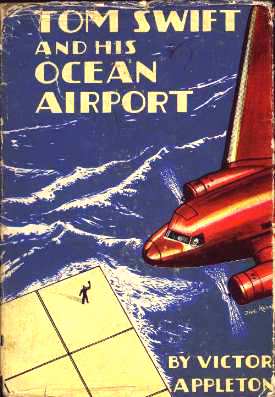 Note:
some of the language, references & attitudes, while acceptable at the time they
were written, are not Politically Correct, today.
Note:
some of the language, references & attitudes, while acceptable at the time they
were written, are not Politically Correct, today.Tom Swift and His Ocean Airport
or, Foiling the Haargolanders
By Victor Appleton ©1934 Book #37
Review by JP Karenko, January 2006
 Note:
some of the language, references & attitudes, while acceptable at the time they
were written, are not Politically Correct, today.
Note:
some of the language, references & attitudes, while acceptable at the time they
were written, are not Politically Correct, today.
Summary:
No official summary was ever provided with any of the old Tom Swift books. However, without giving too much away, the plot can be summed up as follows:
"Mayday! Mayday!! I am going down!!!" The cry for help over the ether heralds the beginning of a new adventure for Tom Swift. A boyhood chum, one Jerry Mason, is on a solo record-setting distance crossing of the Atlantic, a la Charles Lindbergh, but by a longer route. He is being forced down by a rival flyer, who is taking a tom-cat's approach to competitors-that is, "kill 'em all." If only there were a place to land...
Tom decides that maybe an artificial island airport might have saved the day. He goes about designing one that can come apart into smaller sections in a controlled fashion instead of breaking up should a storm threaten it. It is to be made from a light but strong wood called Talcap. This material is only found in a certain South American Republic. Unfortunately, Tom finds out that a Presidente in the palace is NOT worth two in the jungle. A regime change after the wood is purchased puts the entire project (and Tom & Co.) at risk. It is said that "an honest politician is one who stays bought." These boys aren't honest, and they play rough.
How this ends, you will have to locate a hardcover copy of the book to find out. I have not been able to locate it on line. Sorry.
![]()
Cast of Characters (More or less in order of appearance)
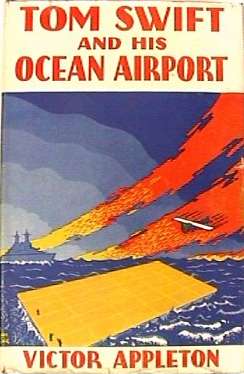 Tom
Swift-Intrepid inventor & mechanic. Plucky, lively, resourceful, brave and
clever. Home-schooled at a college level by his father, Barton Swift. Athlete
and hunter. Familiar with how to stalk game and firearms. Loves all things
mechanical
Tom
Swift-Intrepid inventor & mechanic. Plucky, lively, resourceful, brave and
clever. Home-schooled at a college level by his father, Barton Swift. Athlete
and hunter. Familiar with how to stalk game and firearms. Loves all things
mechanical
Ned Newton-Chum & companion of Tom. His description is never given. He continues in his position as Swifts' financial advisor and CFO (Treasurer) of Swift Construction Company (SCC). In this tale, he repeatedly cautions Tom about a new hire, one Emil Gurg. Tom, as usual, ignores him.
Koku-Giant manservant of Tom. Devoted, loyal, and possessed of great strength, but apparently somewhat limited cognitive facilities. Described as "savage and only half-tame," he is antagonist and rival of Eradicate. In this episode, he has shrunk, and is only "a veritable giant." He continues as watchman & guard at SCC .
Eradicate Andrew Jackson Abraham Lincoln Sampson, A.K.A. Rad-Aged stereotypical Negro manservant. He is now going deaf and is described as "aged, decrepit, wizened and shuffling." He remains faithful to the Swift family and helps out where he can. He is a constant rival and antagonist of giant Koku.
Gerald "Jerry" Mason-No description, other than "tall and young." Boyhood chum of Tom Swift, he resides "out West." An aviator determined to push the envelope of flight, he plans to fly the Atlantic non-stop in his monoplane the Sallie Lou.
Mechanical Mike-No name or description. Airport grease-monkey who delivers a message to Tom.
Mr. Wakefield Damon-Elderly & eccentric adventurer whose main purpose in life seems to be blessing everybody and everything near his person. Never fully described, in previous tales he was "portly" with a moustache and "tortoise-shell glasses." He is quite wealthy and on the board of Waterfield Bank. While he has an ongoing problem with travel conveyance trouble, in this tome, he doesn't manage to smash anything. Off the leash and running wild, as his wife is out of town. She spends a lot of time at her mother's and considering Mr. D was described as "elderly," she may be providing elder care.
Zebford Lang-No description. Generic bad guy. Unscrupulous and deadly. Rival of Jerry Mason, he forces Jerry down in mid-ocean, so he can be the first to cross the Atlantic by way of Portugal/Spain.
Airport Al-No name or description. Brings Tom news of conflict between Jerry and Zeb.
Emil Gurg, nee Gurganzuoli-Small, neatly dressed engineering assistant hired by Tom. Darkly tanned, with very white teeth and a "professional air," he ingratiates himself into the Swift organization. Later found to be a spy/agent provocateur for the government of Haargoland.
South Gate Sam-Nameless and faceless Swift watchman, who admits Gurg to SCC after hours. That south entrance seems to be the weak spot in SCC's perimeter. In the previous episode, Sam was tending his tomato patch instead of watching the gate.
Tom's Secretary-No description. May be a Miss Mapes , previously introduced as in episode #34. Walk-on part.
Captain Blare, USN-Washington chair warmer. Wants Tom to build the airport as a military base.
Lt. Bradford, USN-Adjutant assigned to Tom as liaison with Washington.
Hargsander-NFN or description. California Amateur Radio operator contacted by Tom during wireless test.
Aircraft Al-NFN or description. Faceless SCC pilot/mechanic.
Senor Zaraft-Deposed Presidente of Haargoland. On the outside, trying to get in.
Senor Pocktal-Temporary Presidente of Haargoland. On the inside, but soon to be out.
Haargo Harry- NFN or description. Co-conspirator of Emil Gurg.
Capt. "Harry" Benson, USN- No description. Commander of SS Whale.
Seaman James Thurber, USN- No description. Navy rating injured during airport construction.
Mr. (Probably Lt. Cdr.) Turner, USN- NFN or description. XO of SS Whale.
Sailor Sal, USN- NFN or description. Navy rating. Bit part.
Lt. Hardy, USN- NFN or description. Bridge watch officer, SS Whale.
Commodore Lascado, NRH (Navy of the Republic of Haargoland) -NFN or description, other than "wearing much gold braid." Captain, NRH Talcap.
Lt. Zaldo, NRH- NFN or description, other than "wearing much gold lace." Commander, boarding party.
Lt. Manchez, NRH- NFN or description, engineer/pilot commanding prize crew of SS Whale.
Captain "Bob" Perkin, USN- NFN or description. Captain, USN Hornet..
Jack Bentley- No description. Friend of Jerry Mason.
Dinghy of Disgruntled Diplomats-Planeload of politicians, saved from a water landing by Tom's conveniently placed airport..
Major characters not appearing in this story:
Barton "Bart" Swift- Tom's aged father.
Mrs. Mary Nestor Swift-Radiant bride of Tom.
Mrs. Baggert-Housekeeper/surrogate Mother to Tom while he grew up.
Helen Morton-No description. Love interest of Ned Newton
Garrett Jackson-Swift Construction Works Manager/Superintendent.
As is usual lately, many of these characters (especially the ones introduced late in the story) do not rate any development or even a description. They are brought forth and discarded after they do their bits to make the story flow. The (hopefully humorous) alliterative names are my "inventions" to make reading these reviews a bit more fun.
![]()
Major Inventions:
Talcap is a light, strong wood like Balsa, which only grows in Central/South America. The Floating Airport is comprised of 36 square segments, constructed from this wood, each 300ft on a side. They are laid out in a 6x6 grid. This results in a platform 1800ft on each edge. Each segment has an open grid construction to minimize the effect of wave action, a submerged weighted keel for stability and wireless-electric powered electromagnets to hold the segments together. The segments can be detached and separated during a storm, to minimize damage from waves. And each section has marker lights so they can be found if separated.
The Soundless Wireless also plays a major role in the story. This device is constructed in a manner that permits radio telegraphy without the usual Snap-Crackle-and-Bang of then current technology radio sets.
![]()
Commentary on Society, Attitudes, Environment & Errata
Reading the old Tom Swift Sr. series has really given me an appreciation of all the modern gadgets that I've come to take for granted. It also has given me a grasp of just how technologically and culturally unsophisticated the average reader was in the early 1900's.
Attitudes and Prejudices- Some clews (although that term is no longer used) that were detected as to the author of this tale: This tale reeks with the usual string of coincidences that are required to allow the story line to progress. There is also a lot of repetition to pad the text and raise the page count. The story also requires significant foreboding, (bordering on clairvoyance) to prepare for events that make the plot flow. The author's nautical and engineering knowledge is iffy, and many things are not described correctly. Language remains mostly modern with a few older British terms thrown in. The word "Jove" was sworn by three times and "throng" was used three times. (This is the first recurrence of throng since Episode #5 the Electric Runabout.)
Language in this tale is somewhat strange. Grammar is proper with only 1 each misspelling and malapropisms found. (See below.) A number of "$64" words are used, almost as if the author spent some time looking for complex ways to say simple things. One example, is the Koku is said to speak "sententiously." sen…ten…tious, an adjective, is defined as:
Terse and energetic in expression; pithy.
Abounding in aphorisms.
Given to aphoristic utterances.
Abounding in pompous moralizing.
Given to pompous moralizing.
This term does not properly describe the language of a near illiterate giant who traditionally speaks mostly like a Hollywood Indian, and is generally limited to making statements like "Me break-um in pieces." Frankly, it sounds more like Our Hero...
The language used definitely points at Harriet Stratemeyer's touch, but the story line seems 'way too rough for her to have actually penned it. Tom gets burned, bombed, chased by sharks, captured, imprisoned and caught in a naval bombardment. About the only traditional hazards the author didn't pull out of the hat were the chloroform and electrocution. This is also the first tale where there are mass casualties as a part in the plot. This, might make me think of this author as "Navy Nick," except that whoever wrote it was woefully uninformed as to Navy traditions and operating procedures. I'd hang responsibility for it on Nick, but only tentatively.
Firearms have been utilized in other stories, but usually for intimidation value during break-ins. No one actually gets shot. This is the third story that I have read which includes an actual firefight. It is the first with wholesale injury & fatalities during the climactic naval battle with the bad guys. (pp, 187-189). Surprisingly, there is also no emphasis whatsoever on hard times or on finances and money troubles. This is 1934 and the Great Depression is still gripping the world by the throat. The Austrian paperhanger running the Reichstag in Berlin doesn't seem to be getting any press, either.
Fancy hats sell for $5, and now a "government permit" is needed to make transcontinental or other record setting flight attempts.
Why Build This Airport? ń In a word, altruism. Tom, never was able to turn down the opportunity to rescue someone, anyone... He wants a "safe haven" for aviators, mid-ocean. Coincidently, a floating US military presence (aircraft carriers were still a few years away) would be an added benefit. What this project cost and how the funds expended were recovered was not chronicled in the story. Apparently Swift Construction, previously in dire financial distress, has picked up much business again, as Tom seems willing to give the airport to "Uncle Sam," gratis.
Errata-There is a running gag throughout this series. Mr. Damon's home keeps flip-flopping between Waterfield and Waterford, NY. Sometimes it is in neither, and several times in both places, at once. This is partly due to the enforced poor communication amongst the many ghostwriters at G&D that contributed to this series.
There are now 4 distinct categories. In this tome, Mr. D's home is not specified.
The tally for 37 volumes, to date is:
Waterfield-17, Both places-2, Waterford-10, Neither place-7, Not Specified-8.
A few typos and malapropisms reared their ugly heads for the first time in a long while. Propellors are found early on and on p27, the sounding wireless (soundless) is referenced. Ned sends the wrong Morse code at the beginning of the story. He intends to send "SOS" dot-dot-dot, dash-dash-dash, dot-dot-dot. Instead, he sends "SIS" dot-dot-dot, dash-dash, dot-dot-dot.
.It has previously been de rigueur for Tom to "rescue" someone, anyone, at least once per episode. In this tome, he saves a Navy rating who gets a hand caught in the gears of a windlass/hoist. That this fellow did not suffer major damage to his limb is fantastic, and that Tom now has surgical skills and is able to doctor the injury is even more fantastic. Where is the ship's Corpsman? This is a Navy vessel and crew. It's woefully understaffed, if you ask me... He also saves a plane load of diplomats late in the tale. I'm not sure if this was worth the effort, though. (I have a low opinion of diplomats...)
The Whale (nee Resolute) has a "purser" on board that Tom goes to see. I think the proper Navy rating would be either a Chief Petty Officer (CPO), or maybe even a Senior CPO in the Quartermaster Corps. While decommissioned as a battle platform, the ship is still under the command of the US Navy. This further demonstrates this author's lack of knowledge re Things Nautical.

CPO (Quartermaster) Rank Flash (2005)
More about Navy ratings can be learned from the following site: http://www.chinfo.navy.mil/navpalib/ranks/ratings/admin.html
Renaming battleships was not a common practice, at least in the US Navy. More can be learned about such things at http://www.friesian.com/dreadnot.htm . Generally, when a name gets changed, it is for an entire class of ship. Exceptions did occur, such as in the USS Narwhal (Submarine # 17, later SS-17 in service from 1909-1922.) It was renamed D-1 in 1911. Most times, "renaming" is actually reusing of a name, to replace a ship either lost in battle or one previously retired and being resurrected. Then, almost always, the name is used on a different class of boat. Renaming a battleship, no matter how obsolete, from Resolute to Whale sounds like an insult.
Engineering and Science, Fact vs. Fantasy-
The Floating Airport Concept-
Flotation: Talcap sounds a lot like Balsa wood. Balsa is light, strong and grows only in the tropics. I believe it would have to be treated to stay waterproof for any length of time, and to make it unpalatable to sea-critters (worms and such.) I'm sure that sea-dwellers would consider it a tasty snack. No provision was made for things like runway lights, beacons, hangars, fuel tanks, maintenance/repair facilities or other amenities. This is just a big old floating dry spot. Any port in a storm beats drowning, I guess... (Where's that porta-potty???)
Some Assembly Required: The Floating Airport is comprised of 36 square segments, each 300ft on a side, and laid out in a 6x6 grid. This gives a platform 1800ft on each edge. Each segment has an open grid construction to minimize the effect of wave action, a submerged weighted keel for stability and wireless-electric powered electromagnets to hold the segments together. The wireless power system is practical, as demonstrated in the late 1890's by the inventor Nikolai Tesla, known as the "Father of Alternating Current."
The magnet arrangements that were used to hold the airport together the airport were not detailed, but for safety's sake, I'd design the array so it had some rigidity without the magnetic help. Machinery was notoriously unreliable in those days, and I can envision a planeload of VIP's in the drink because of an inopportune blown fuse.
The Soundless Wireless- http://www.sparkmuseum.com/WIREREC.HTM
The noisy parts of early radio-telegraphy gear were the spark gap in the transmitter and the coherer in the receiver. How Tom goes about reducing the noise these components make is left to the imagination of the reader. The noise generated by the spark gap during transmitting is created by the arc superheating the air across the gap. Basically, we are creating lightning and a thunderclap in miniature form. The coherer, as invented by Branly and refined by Marconi, was essentially a go-no-go device. In the presence of a magnetic field created by an incoming signal, its particles "cohered" and lost most of their electrical resistance so that a battery derived electric current could be directed through the device and activate a telegraphic sounder. Then the coherence would be mechanically interrupted (the noisy part-they bang on the tube) while the system awaits the next pulse of magnetic energy. This was satisfactory for telegraphy only, and it would not respond to reception of sound-modulated electromagnetic waves.
An example of the Ducretet "exceptional precision coherer" is shown, below. Made of Maillechort alloy (copper+nickel+zinc), it was used principally by the Russian navy. (1904-1905) The tube containing the conductive filings is orange. Image courtesy of http://jcverdier.museum.online.fr/
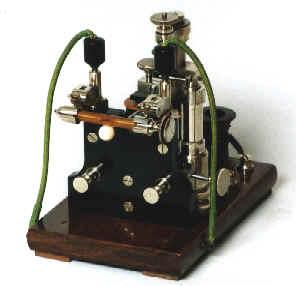
Almost as an aside, if Tom had been willing to "send" blind, without receiving, he would have reduced his noise output by at least 50% without any special equipment. Another thought had to do with military radio discipline. If I were to commit an act of war on the high seas, I'd want to make darn sure no one sent an SOS by monitoring the airwaves. The braid-encrusted political appointees in the Haargo Navy apparently didn't figure out that there might be a third transmitter on board the Whale. Their spy used his own set. Why could there not be another one in the hands of the good guys?
Tsunami - An item of engineering balderdash in this story, has to do with an underwater earthquake creating an EMP type disturbance powerful enough to knock out major ships' systems. A quick research on Google using Tsunami and EMP (Electro-Magnetic Pulse) turned up the following web document:
http://www.tifac.org.in/do/pfc/pub/dec04.pdf It is a patent application for a "Tsunami Detector" that can be used as part of a warning system. It turns out that tsunamis do generate an EMP, but the magnitude is measured in nano-teslas, on the order of one ten-thousandth of a gauss. A typical "bar" magnet has a strength of about 100 gauss or about .001 tesla. A real-life pulse would probably make the ship's compass quiver for about as long as it was happening. It was said that the actual duration of the 2004/05 Indonesia tsunami earthquake was on the order of eight minutes.
Assuming the damage quoted above, was actually done, Tom has to work night and day to repair the damage. Single-handedly? Were there no ratings on board qualified to help? Or, for that matter, to do the work without Our Hero's expert direction?
If the Germans knew our Naval ships were such pushovers, (remember, it's 1934) Adolph & Co. would have been barking at the base of the Statue of Liberty und ve vould all be shpeakingk mit ze cherman akzent, ja wohl?
Shark Tales- Tom punches a shark in the nose and drives it off, leaving a bloody trail in the water. When I first read this, I laughed. Sharks are tough critters and generally win any argument involving an unarmed human swimmer. The shark's bloody nose really is balderdash, but the following article leaped off the page while I was cruising the 'net.
Dad fights off sharks by Michael Madigan 13Dec05
A MELBOURNE builder punched a shark as he fought off a pack of the predators attacking him and his 15-year-old son. Glenn Simpson, 44, lost a large chunk out of his right elbow and received 30 puncture holes in his arm during the desperate struggle...
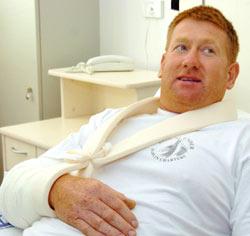
The complete text can be found at :
http://www.heraldsun.news.com.au/common/story_page/0%2C5478%2C17547738%25255E2862%2C00.html
Seems that we have to add "light heavyweight contender" to Tom's resume... It's unlikely the blood in the water was the shark's. Shark hide is rough as sandpaper and is leather tough. Most likely, Tom skinned his knuckles duking it out with the ferocious finned forager.
Geography- Shopton is back to being a "small city in an eastern state."
The Floating Airport is said to be anchored more or less at the coordinates 45deg N. Lat and 45deg W. Long. Coincidently, this area is near the Mid-Atlantic Ridge, where two continental plates are separating. Sub-ocean earthquakes are indeed common, and this would lend credence to the events (but not the EMP) in the story. The tsunami created by this disturbance should have been felt in both Europe and the USA.
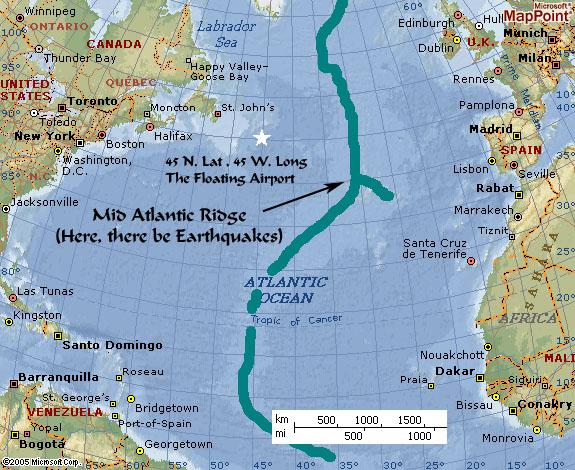
If Haargoland was a Central/South American country, their navy was quite brave, venturing into waters populated by both the British Fleet and German U-Boats.
JP Karenko, 01/04/06
![]()
Tom Swift and his Television Detector | Tom Swift and his Planet Stone | Back to the Index